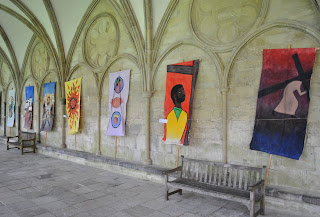
Today we visited the magnificent British Library, England's national library. The closest analogue in the US is the Library of Congress, but having had the privilege of using the Library of Congress, I'd have to say that the British Library is a less imposing institution--I mean that in a good way! The Library's lobby is open to anyone, and while there are bag inspections, both for security and loss prevention, there aren't metal detectors like there are at Library of Congress. I was also a little surprised that you can take bags and laptops in to the reading rooms, though some items are limited. Last time I was at the Library of Congress a couple of years ago, you had to leave everything but a notepad and pencil outside before you could go into the reading area. The Library has made a real effort to be integrated into the community it sits in as well. I can't image the Library of Congress allowing ping pong in front of the building, or outdoor concerts. On the other hand, the Library of Congress' neighbors are other government buildings, so there's really no neighborhood to speak of.
Our guide was very emphatic that the Library is a working library, not a "museum of books." (Though the King's Library, which was the personal collection of King George III, that lies at the heart of the Library is so gorgeous it seems like a work of art. The spines of all those magnificent old books look out at you through glass.) The reading rooms are generally close to full, with humanities reading rooms at 96-98% of capacity most of the time. The Library adds about 250-350 new reader's cards a day. You have to show proof of address (anywhere in the world) and an ID with a signature, and there are really, really no exceptions; the Queen's grandniece and the Mayor of London had to show their IDs, so don't think you can get out of it! Unfortunately, like libraries everywhere, the Library is concerned that its funding will cut in the upcoming wave of belt tightening that's expected from the British government. Fortunately, publishers are required by law to deposit one copy of every book they publish in the UK at the Library, so the Library will at least continue to acquire British books. The acquisitions budget of the Library is devoted to foreign works and special purchases that add value to the collection, and I imagine that will likely be trimmed.
One thing I didn't expect was the Library's Business and Intellectual Property (IP) Centre, probably a big part of how it generates value added services. About 17% of the Library's user base come to the Library to use these services, and the Library has an impressive array of databases and other materials to help them. The Library also has free in person and online courses in understanding IP and searching IP databases. (I'm super-excited about the online courses, and I know that's kind of sad. Who gets excited about the thought of learning how to search British patents?)
I did know about the magnificent collection of printed materials that the Library has, but I didn't realize how much they have on display. You can see both a Gutenberg Bible and handwritten lyrics by the Beatles. (As an aside, I loved the fact that the display explained that we know so much about how the Gutenberg Bible was printed because of court documents generated when Gutenberg and his partner fell out immediately after the books was printed and sued each other. So, right from the start the publishing business was litigious.) As the Library is a working library, even the extremely rare works on display can be used under special circumstances. An original Jane Austen manuscript was pulled from display for use by an Austen scholar a few years back.

A final note is this sculpted bench sitting in the lobby of the library, a reference to many things, including medieval chained manuscripts. The guide explained that the sculpture is called "Sitting on the Past," because the artist believes that we don't learn from our past, even when we learn about it. I'd add a slightly more optimistic note that it's only when we have institutions like the British Library and other major libraries and archives available to anyone that wants to use the materials that we have any hope of learning from the past at all.















































